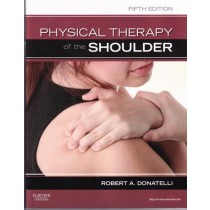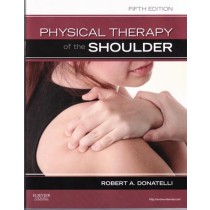
Physical Therapy of the Shoulder, 5th Ed: Module 1
SKU: 731
By Robert A. Donatelli, PhD, PT, OCS
This course is offered in cooperation with Elsevier Science and utilizes the textbook, “Physical Therapy of the Shoulder, 5th Ed”, c2012, edited by Robert A. Donatelli, PhD, PT, OCS. Dr. Donatelli is a certified Orthopedic Clinical Specialist with over 30 years of clinical hands-on experience.
This textbook is the leading reference on the shoulder and is now completely up-to-date with state-of-the-art rehabilitation and surgical techniques. It is an essential resource to the therapist, providing valuable information on functional anatomy, the mechanics of movement, neurologic, special, and surgical considerations and evaluation and treatment. This new edition provides new information, concepts, and evaluation of physical therapy and dysfunction based on the APTA Guide to Physical Therapy Practice, 2nd Ed and integrates these practice patterns with rehabilitation of the shoulder.
These courses are essential to therapists treating shoulder injuries in all rehabilitation settings!
Module 1 covers the mechanics of movement and evaluation including the guide to practice, functional anatomy and mechanics, throwing injuries and examinations and evaluation of the shoulder
Module 2 covers neurologic considerations including the interrelationship of the spine, rib cage and shoulder, neural tissue evaluation and treatment, sensory integration and neuromuscular control of the shoulder and evaluation and treatment of brachial plexus lesions.
Module 3 covers special considerations including impingement syndrome and impingement-related instability, frozen shoulder, evaluation and rehabilitation of rotator cuff pathologic conditions and rehabilitation and visceral pain referred to the shoulder
Module 4 covers treatment approaches including manual therapy, muscle length testing and electromyographic evidence for manual strength testing and exercises for the shoulder, rotator cuff repairs and surgical approaches to shoulder instabilities
Course Length: 8.0 contact hours
Instructional Level: Beginner/Intermediate
This package contains the required reading and test materials for Module 1 only.
Physical Therapy of the Shoulder, 5th Ed: Module 1
Course Goals and Objectives:
Course Goals:
This course is intended to instruct the student through self-paced study on the mechanics of movement and evaluation of the shoulder.
Student Objectives:
At the end of this course the student will be able to:
1. Identify 4 purposes of the “Guide”.
2. Identify the 4 stages in the Nagi Model of Disablement.
3. Identify the 6 elements of patient management.
4. Identify the 3 types of arthrokinematic motion
5. Identify the strongest supporting ligament of the glenohumeral joint.
6. Identify the static stabilizers of the glenohumeral joint
7. Identify the dynamic stabilizers of the glenohumeral joint
8. Identify the 3 phases of shoulder elevation
9. Identify the 5 phases of an overhand throw
10. Identify 5 roles of the scapula
11. Identify the 3 major components of a SICK scapula
12. Identify 5 common symptoms accompanying a SICK scapula
13. Identify the “Rotational Unity Rule”
14. Identify 3 scapular patterns related to shoulder injuries in the overhand-throwing athlete.
15. Identify 5 scapular mobilization techniques
16. Identify 10 posterior-inferior capsule stretching techniques
17. Identify 3 tabletop scapular exercises
18. Identify 6 shoulder wall exercises
19. Identify 6 prone shoulder exercises (The Six Back)
20. Identify 5 mass movement patterns
21. Identify components of an off-season upper extremity conditioning protocol for overhand-throwing athletes
22. Identify components of an arthroscopic repair of a SLAP lesion in a throwing athlete
23. Identify components of a nine-level rehabilitation throwing program
24. Identify 10 questions that should be answered by a patient during an evaluation
25. Identify 3 special tests for glenohumeral stability
26. Identify 6 special tests for labral integrity
27. Identify 3 special tests for shoulder impingement
28. Identify 4 special tests for identifying dysfunction of specific muscles and tendons of the shoulder
29. Define “shoulder impingement”
SKU: 731
By Robert A. Donatelli, PhD, PT, OCS
This course is offered in cooperation with Elsevier Science and utilizes the textbook, “Physical Therapy of the Shoulder, 5th Ed”, c2012, edited by Robert A. Donatelli, PhD, PT, OCS. Dr. Donatelli is a certified Orthopedic Clinical Specialist with over 30 years of clinical hands-on experience.
This textbook is the leading reference on the shoulder and is now completely up-to-date with state-of-the-art rehabilitation and surgical techniques. It is an essential resource to the therapist, providing valuable information on functional anatomy, the mechanics of movement, neurologic, special, and surgical considerations and evaluation and treatment. This new edition provides new information, concepts, and evaluation of physical therapy and dysfunction based on the APTA Guide to Physical Therapy Practice, 2nd Ed and integrates these practice patterns with rehabilitation of the shoulder.
These courses are essential to therapists treating shoulder injuries in all rehabilitation settings!
Module 1 covers the mechanics of movement and evaluation including the guide to practice, functional anatomy and mechanics, throwing injuries and examinations and evaluation of the shoulder
Module 2 covers neurologic considerations including the interrelationship of the spine, rib cage and shoulder, neural tissue evaluation and treatment, sensory integration and neuromuscular control of the shoulder and evaluation and treatment of brachial plexus lesions.
Module 3 covers special considerations including impingement syndrome and impingement-related instability, frozen shoulder, evaluation and rehabilitation of rotator cuff pathologic conditions and rehabilitation and visceral pain referred to the shoulder
Module 4 covers treatment approaches including manual therapy, muscle length testing and electromyographic evidence for manual strength testing and exercises for the shoulder, rotator cuff repairs and surgical approaches to shoulder instabilities
Course Length: 8.0 contact hours
Instructional Level: Beginner/Intermediate
This package contains the required reading and test materials for Module 1 only.
Physical Therapy of the Shoulder, 5th Ed: Module 1
Course Goals and Objectives:
Course Goals:
This course is intended to instruct the student through self-paced study on the mechanics of movement and evaluation of the shoulder.
Student Objectives:
At the end of this course the student will be able to:
1. Identify 4 purposes of the “Guide”.
2. Identify the 4 stages in the Nagi Model of Disablement.
3. Identify the 6 elements of patient management.
4. Identify the 3 types of arthrokinematic motion
5. Identify the strongest supporting ligament of the glenohumeral joint.
6. Identify the static stabilizers of the glenohumeral joint
7. Identify the dynamic stabilizers of the glenohumeral joint
8. Identify the 3 phases of shoulder elevation
9. Identify the 5 phases of an overhand throw
10. Identify 5 roles of the scapula
11. Identify the 3 major components of a SICK scapula
12. Identify 5 common symptoms accompanying a SICK scapula
13. Identify the “Rotational Unity Rule”
14. Identify 3 scapular patterns related to shoulder injuries in the overhand-throwing athlete.
15. Identify 5 scapular mobilization techniques
16. Identify 10 posterior-inferior capsule stretching techniques
17. Identify 3 tabletop scapular exercises
18. Identify 6 shoulder wall exercises
19. Identify 6 prone shoulder exercises (The Six Back)
20. Identify 5 mass movement patterns
21. Identify components of an off-season upper extremity conditioning protocol for overhand-throwing athletes
22. Identify components of an arthroscopic repair of a SLAP lesion in a throwing athlete
23. Identify components of a nine-level rehabilitation throwing program
24. Identify 10 questions that should be answered by a patient during an evaluation
25. Identify 3 special tests for glenohumeral stability
26. Identify 6 special tests for labral integrity
27. Identify 3 special tests for shoulder impingement
28. Identify 4 special tests for identifying dysfunction of specific muscles and tendons of the shoulder
29. Define “shoulder impingement”





